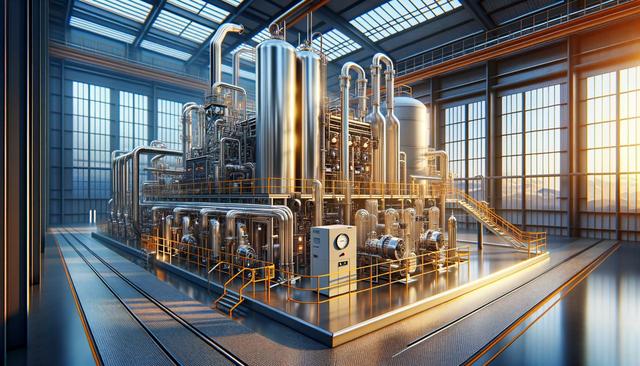Understanding the Role of Carbon Capture Equipment
Carbon capture equipment plays a pivotal role in addressing global greenhouse gas emissions. As industries strive to meet stricter environmental standards, this technology is becoming increasingly essential in reducing carbon dioxide output. The equipment works by capturing CO2 emissions at their source—typically power plants or industrial facilities—before they enter the atmosphere. Once captured, the CO2 can either be stored underground or reused in different industrial processes. The growing emphasis on sustainable industrial practices has placed a spotlight on the development and deployment of carbon capture systems, prompting manufacturers to innovate and scale up their solutions for broader application.
While the core function of carbon capture remains the same, the design and efficiency of the equipment can vary depending on the sector it serves. For example, systems used in the cement industry may differ from those used in oil and gas operations. This diversity has led to a competitive market where equipment manufacturers are constantly optimizing their technologies to meet specific industry needs while remaining cost-effective and energy-efficient.
Leading Manufacturers and Their Technological Contributions
Several manufacturers have emerged as key players in the advancement of carbon capture equipment. These companies are not only refining existing technologies but also developing new methods to enhance capture rates and reduce operational costs. Their innovations are critical in making carbon capture a more viable option for industries ranging from power generation to chemical manufacturing.
Key areas of innovation include:
- Advanced sorbents and solvents that improve CO2 absorption rates
- Modular systems that allow for easier integration into existing infrastructure
- Automation and digital monitoring to optimize performance and maintenance
These technological improvements make carbon capture systems more adaptable and efficient, encouraging broader adoption across sectors. As more manufacturers enter the market, collaboration and standardization efforts are also taking shape, further accelerating the deployment of these crucial systems.
Scalability and Deployment Challenges
Despite significant progress, scaling up carbon capture equipment across industries presents several challenges. One of the most pressing issues is the high initial investment required for installation and operation. Many facilities, particularly in developing economies, may lack the financial resources or technical expertise to implement these systems effectively.
Other common challenges include:
- Limited infrastructure for transporting and storing captured CO2
- Regulatory hurdles that delay project approvals
- Uncertainty in carbon pricing and incentives
Manufacturers are responding by designing equipment that is more modular and cost-effective, reducing the upfront costs and complexity of implementation. Additionally, partnerships between private companies and public institutions are helping to address infrastructure and regulatory gaps, paving the way for more widespread use of carbon capture technologies.
Applications Across Industries
Carbon capture equipment is being adopted across a wide range of sectors, each with unique needs and benefits. In the energy sector, power plants are incorporating capture units to limit emissions from fossil fuel combustion. The cement and steel industries, known for their high carbon footprints, are also integrating these systems to meet regulatory and environmental goals.
Notable applications include:
- Petrochemical plants utilizing captured CO2 in enhanced oil recovery (EOR)
- Bioenergy facilities combining carbon capture for negative emissions
- Waste-to-energy plants using carbon capture to reduce overall emissions
This diversity in application demonstrates the flexibility and broad relevance of carbon capture equipment. As manufacturers continue to innovate, these systems are becoming more tailored to specific operational environments, enhancing their effectiveness and making them a more attractive investment for a variety of industries.
The Future of Carbon Capture Technology
Looking ahead, the future of carbon capture equipment is closely tied to advancements in research, policy support, and market demand. New materials and engineering designs promise to reduce the energy requirements of capture processes, making them more sustainable and economically viable. Additionally, as global climate targets push industries toward net-zero goals, the role of carbon capture will likely expand even further.
Manufacturers are expected to play an integral part in this evolution by:
- Investing in R&D to develop next-generation capture technologies
- Collaborating with governments and NGOs to create supportive regulatory environments
- Expanding production capacities to meet growing global demand
With these ongoing efforts, carbon capture equipment is positioned to become a central component of industrial decarbonization strategies worldwide. By addressing both technological and operational barriers, manufacturers are helping drive a shift toward more sustainable industrial practices.
Conclusion: Supporting Emission Reduction Through Innovation
As the urgency of climate action continues to rise, carbon capture equipment stands out as a practical and scalable solution for reducing industrial emissions. Manufacturers in this space are leading the charge by developing innovative, cost-effective, and adaptable technologies that cater to various sectors. While challenges remain, particularly around cost and infrastructure, the collaborative efforts between industry leaders, policymakers, and researchers offer promising pathways forward. For industries seeking to align with environmental goals and regulatory frameworks, investing in carbon capture solutions represents a tangible step toward a lower-carbon future.




Leave a Reply